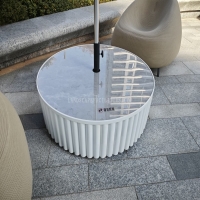Welcome to the website for landscape facilities products and knowledge.
How does concrete resist carbonation?
Concrete resists carbonation through a combination of its inherent chemical properties and physical structure. The primary defense mechanism lies in its high alkalinity, with a pH typically around 12-13 due to calcium hydroxide (Ca(OH)₂) present in hydrated cement. This alkaline environment neutralizes acidic carbon dioxide (CO₂) that penetrates the surface, forming calcium carbonate (CaCO₃) in a process called carbonation.
The dense microstructure of quality concrete also acts as a barrier, limiting CO₂ diffusion. Properly cured concrete with low water-cement ratio develops fewer pores, significantly slowing carbonation progression. Additionally, supplementary cementitious materials like fly ash or slag can refine pore structure further.
Surface treatments such as sealants or coatings provide extra protection by creating an impermeable layer. While carbonation is inevitable over decades, these resistance mechanisms ensure concrete maintains its structural integrity for most practical service lives. Regular maintenance and quality mix design remain crucial for optimal carbonation resistance.
Related search:

Recommendation
Round metal tube border design table with tempered glass or granite countertop on the top.